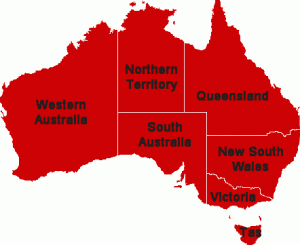 The Northern Territory is a federal territory of Australia, occupying much of the centre of the mainland continent, as well as the central northern regions. It shares borders with Western Australia to the west (129th meridian east), South Australia to the south (26th parallel south), and Queensland to the east (138th meridian east). To the north, the territory is bordered by the Timor Sea, the Arafura Sea and the Gulf of Carpentaria.
The Northern Territory is a federal territory of Australia, occupying much of the centre of the mainland continent, as well as the central northern regions. It shares borders with Western Australia to the west (129th meridian east), South Australia to the south (26th parallel south), and Queensland to the east (138th meridian east). To the north, the territory is bordered by the Timor Sea, the Arafura Sea and the Gulf of Carpentaria.
Despite its large area, over 1,349,129 square kilometres (520,902 sq mi), making it the third largest Australian federal division, it is sparsely populated. With a population of 229,675 it is the least populous of Australia’s eight major states and territories.
The archeological history of the Northern Territory begins over 40,000 years ago when Indigenous Australians settled the region. Makassan traders began trading with the indigenous people of the Northern Territory for trepang from at least the 18th century onwards, and very likely for 300 years prior to that.
The coast of the territory was first seen by Europeans in the 17th century. The British were the first Europeans to attempt to settle the coastal regions in the 19th century; however no attempt was successful until the establishment of a settlement at Port Darwin in 1869. Today the economy is based on tourism, especially Kakadu National Park in the Top End and the Uluru-Kata Tjuta National Park (Ayers Rock) in central Australia, and mining.
The capital city is Darwin. The population is not concentrated in coastal regions but rather along the Stuart Highway. The other major settlements are (in order of size) Alice Springs, Katherine, Nhulunbuy, and Tennant Creek. Residents of the Northern Territory are often known simply as ‘Territorians’.
Content from this page is drawn from Here.

